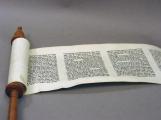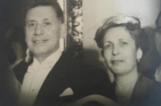1
Heirlooms from the Eskenazi Family2
The Megillat Esther, or Book of Esther, records the story of the holiday of Purim and is read every year as a way of marking and celebrating the holiday. The villain of the story is Haman, an advisor to the Persian King Ahasuerus. In the fifth century B.C.E., Haman plotted to kill all of the Jews of Persia. The heroine is Esther, a Jewish woman who conceals her identity and marries the King. She and her Uncle Mordechai reveal Haman's wicked deeds to the King, thereby foiling Haman's plot and saving the Jews of Persia.3
Many Jewish holidays revolve around such stories. The Jewish people have been threatened and endangered time and time again. Holidays such as Purim, Passover and Chanukah celebrate God's providence and our survival. Yet there are many other such stories that are not celebrated by holidays and that go unrecorded in our collective history. These stories do not feature traditional villains and heroes, but they are nevertheless stories of courage and endurance.4
One Megillat Esther scroll in the Aron Museum stands as testimony to one such story. The scroll comes from Turkey, and was in the possession of the Eskenazi family for four generation. Beno Eskenazi was the fourth Eskenazi man to possess the scroll, as well as the first of his family to immigrate to Canada. Beno and his wife Goldie have been dedicated members of the Temple since 1965. In 2003, the Eskenazis donated their family heirloom to the Aron Museum.5
Beno Eskenazi was born and raised in Istanbul, Turkey. As a young man, he continually attempted to leave the country. He remembers the year 1942 in particular, when he ran to the American Consulate in order to apply for a visa to move to the United States. He remembers the Americans asking him, "Don't you know there's a war going on?" Beno knew, but it seemed unimportant to him at the time in comparison to the conditions that he and his family were suffering. The Jews of Turkey were taxed heavily and given two weeks to pay, or else were sent to a concentration camp.7
At that time, Beno was still in college. Upon graduating in June of 1946, he immediately started taking steps to leave the country. He left Turkey for France and stayed in Paris while applying to other countries to continue his education. He was soon accepted by McGill University of Montreal, Canada to start working towards his Master's degree in September of 1947.8
He remembers feeling the difference of his new country: "I had lived in France as a tourist, and I didn't see Jewish people or family life in any way... We didn't have much food in France. So it was miserable. I came to Canada and suddenly I found myself this side of heaven. And I met Goldie, my wife."Beno felt lucky to be living in Canada and to be given opportunities that he would not have had in Turkey. Naturally, he desired the same for his family.
10
At first, his parents, Albert and Rachel Eskenazi, were reluctant to join him in Canada. In 1958, twelve years after Beno left Turkey and ten years after marrying Goldie, Albert and Rachel spent the entire summer in Montreal. They returned to Turkey only to liquidate their assets, and were living in Montreal by the summer of 1959. It was Beno's parents that brought the Megillat Esther scroll to Canada. They thereby ensured that a piece of their heritage would be preserved in this new land, amid new customs and traditions.11
Megillat Esther Scroll 'HaMelech Scroll' (Parchment and carved linden wood) Mid 19th centuryDate not available
Çorlu, Turkey

12
While the story recorded in the scroll originates in Persia in the fifth century B.C.E. and records a part of Jewish history, the family history represented by this particular scroll dates back to the mid-nineteenth century in Çorlu, a small town in European Turkey.Beno Eskenazi remembers celebrating Purim in Turkey: "My grandmother used to make candies that she sent to all of her grandchildren, called "mablaja" - mint sticks, hearts, magen davids, and other symbols made out of this candy stick... Actually, in school, I went to Jewish school in Turkey, and we put on plays. I remember I was Mordechai."
13
Megillat Esther Scroll 'HaMelech Scroll' (Parchement and carved linden wood) Mid 19th centuryDate not available
Çorlu, Turkey


